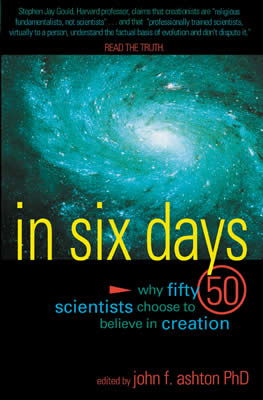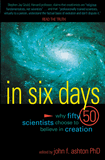
Chapter 10
John R. Rankin, Mathematical Physics
The creationist approach allows us to have an exceedingly intricate and beautiful world at the outset, ready for us to explore its wonders scientifically.
is senior lecturer in the Department of Computer Science and Computer Engineering, La Trobe University, Australia. He holds a B.S. (Hons) with first class honors in applied mathematics from Monash University, a Ph.D. in mathematical physics from the University of Adelaide, and a postgraduate diploma of computer science from the University of Adelaide. He has taught in tertiary institutions for more than 17 years.
When we ask about the origins of everything, what are the choices? We basically really only have two choices: evolution or creation. Evolution has its problems and no scientist denies that. But that doesn’t answer the question of why I believe in creation. Theories can be easily patched up with extra assumptions and more circuitous explanations and couldn’t the problem areas simply be put down to our present state of knowledge? Could we not simply hope that in the not-too-distant future, with further research, each particular thorny problem in evolution will eventually get resolved satisfactorily, one by one? In my perspective, however, if we think of the problem areas in evolution as “holes” in the theory, these holes are getting bigger with time, and they are not going away.
Evolution covers such a wide span of scientific disciplines that no one area is sufficient to disprove the theory.
Evolution covers such a wide span of scientific disciplines that no one area is sufficient to disprove the theory. In earlier days, scientists accepted the assurance that although they had insurmountable difficulties with evolution in their own area of scientific work, evolution “works” and makes sense in other areas of research and in basic science in general. But as time has gone on, the problem areas for evolution in the various disciplines of science have not gone away but remained and are standing out like “sore thumbs.” With this situation, scientists have become aware of the difficulties for evolution in all other areas, in addition to their own. Now they are starting to say that maybe there are fundamental problems with the evolution explanation itself.
Let me describe my original area of research and how it related to evolution theory. My early research work was in the area of cosmology. This involves a deep study of mathematics and astronomy and, in particular, Einstein’s Theory of General Relativity. In cosmology we have a number of “cosmological models” that we study. These are mathematical solutions of the Einstein equations that describe different possible universes allowed according to the laws of physics. My research project was to pursue the question: if the universe started off as a homogeneous distribution of atomic gases and plasma, would the typical small statistical fluctuations in density grow and condense under the known laws of gravity to form protogalaxies, the precursors of galaxies with all their complex constituents of globular clusters, stars, planets, moons, asteroids and comets of today?
This is the current belief of evolution theory: that an initially homogeneous and uninteresting universe became differentiated over billions of years into the complex and beautiful structure of interrelated objects that we know and see today. The attitude of my research supervisor was, “We are here; therefore, we must have evolved!” and by assumption everything evolved from a uniform gaseous state.
This is certainly a big question and to tackle it I looked into the initial phases of this supposed process. So the question I tackled was: would statistical fluctuations in the cosmological models currently believed to be realistic representations of the cosmological structure of the universe grow under the gravitational laws of general relativity to the level of becoming statistically significant? Linearized equations are suitable for the expected background random density fluctuations. If these equations say that, for standard cosmological models, initial random (insignificant) fluctuations will grow over cosmological time (measured in billions of years) to become statistically significant—at which point the linearized equations break down and a fully nonlinear mathematical treatment is required—then we have established the foundations for the evolution theory.
After five years of heavy mathematical research concentrated on this one question, the answer came back: no. Indeed, there was some growth in the initial fluctuations but, even over 10 or 20 billion years, the initial statistical fluctuations in density were still at the level of fluctuation that could be expected on statistical grounds in a homogeneous universe. Previous research had seemed to indicate that statistical fluctuation would condense rapidly. However, these calculations had been done in the background of unrealistic cosmological models, namely models that were static and mostly nonrelativistic. These static models could not be justified either from the point of view of physical theory or from cosmological observations and what we now know about the universe.
Of course, this result was a great disappointment to the strong believers of evolution theory. It seemed obvious that gravity would do this simple chore required at the foundation of evolution theory. What was counteracting the natural force of gravity in condensing fluctuations was the expansion of the universe itself, which is also a product of the laws of gravitation. The standard reaction to such a negative result is to search for alternative considerations, apart from gravity, that could be involved to generate statistically significant fluctuations. For example, thermodynamics, that is, fluctuations in heat distribution and the flow of heat, could “assist” gravity to do its job. Another idea is to invoke the interaction between the different fluid components in the cosmological model: radiation, plasma types and dust. Perhaps the point of decoupling between radiation and matter is a significant enough stimulus to accelerate the process of protogalaxy formation. A third type of mechanism is to resort to turbulence to counteract the disruptive effect of the expansion of the universe on the protogalaxy formation process.
Each of these additional mechanisms in support of galaxy formation brings much greater mathematical complexity to the problem. It is easy to maintain the standard line of evolution theory that a homogeneous gaseous universe evolved into a hierarchically structured galactic universe by invoking complex mechanisms such as these, for which the proof is still outstanding and must remain so for quite some time, because of the enormously increased complexity of the mathematics involved in the new explanations. However, the indications are quite clear that the effects of heat, energy transfers between fluid components, and turbulence are all disruptive to the growth of density fluctuations.
This is an example from one area of research of a major flaw in the evolution explanation from which evolution has never recovered. And yet books still continue to come out in increasing numbers saying that the evolution explanation is correct and incorporating the idea that, early in the universe, gases condensed to form protogalaxies, which further condensed into galaxies of stars and planets with the emergence of life. Do we hear of any of these supporters being willing themselves to spend years of their lives pursuing the complex mathematics involved in their patched-up but unproven theories? Alternatively, are they willing to pay others to do this work and approach the problems objectively, that is, willing to accept that physical theory could result in a negative answer, indicating that their modified explanations are also wrong?
Unfortunately, the supporters of evolution now seem to be less willing to support or pursue this research themselves. As a result, there are few researchers left in the field, with the exception of the changing population of final-year research students. After all the research to date, we are still unable to explain the origin of galaxies as inhomogeneities in the universe from the perspective of evolution. We seem, in fact, to be further away from a satisfactory explanation of evolutionary galactic origins than we were when we started to study the subject, using modern physical theory. As in one field of science, so in all others, we are unable to explain the origin of the beautiful and complex realities of this world from an evolutionist approach.
The burden of evolution is to explain everything, including the mathematics, the logic and the thinking processes involved. This is a burden that increases in size as knowledge continues to grow. It is a burden that takes away our firm foundations for thought and scientific explanation. Maybe the evolutionist approach is wrong, then?
The creationist approach allows us to have an exceedingly intricate and beautiful world at the outset, ready for us to explore its wonders scientifically. This is the approach that puts us on a firm foundation, and this is why I believe in creation rather than evolution.
In Six Days
Can any scientist with a Ph.D. believe in the idea of a literal six-day creation? In Six Days answers this provocative question with 50 informative essays by scientists who say “Yes!”
Read Online Buy BookRecommended Resources

Answers in Genesis is an apologetics ministry, dedicated to helping Christians defend their faith and proclaim the good news of Jesus Christ.
- Customer Service 800.778.3390
- © 2025 Answers in Genesis




